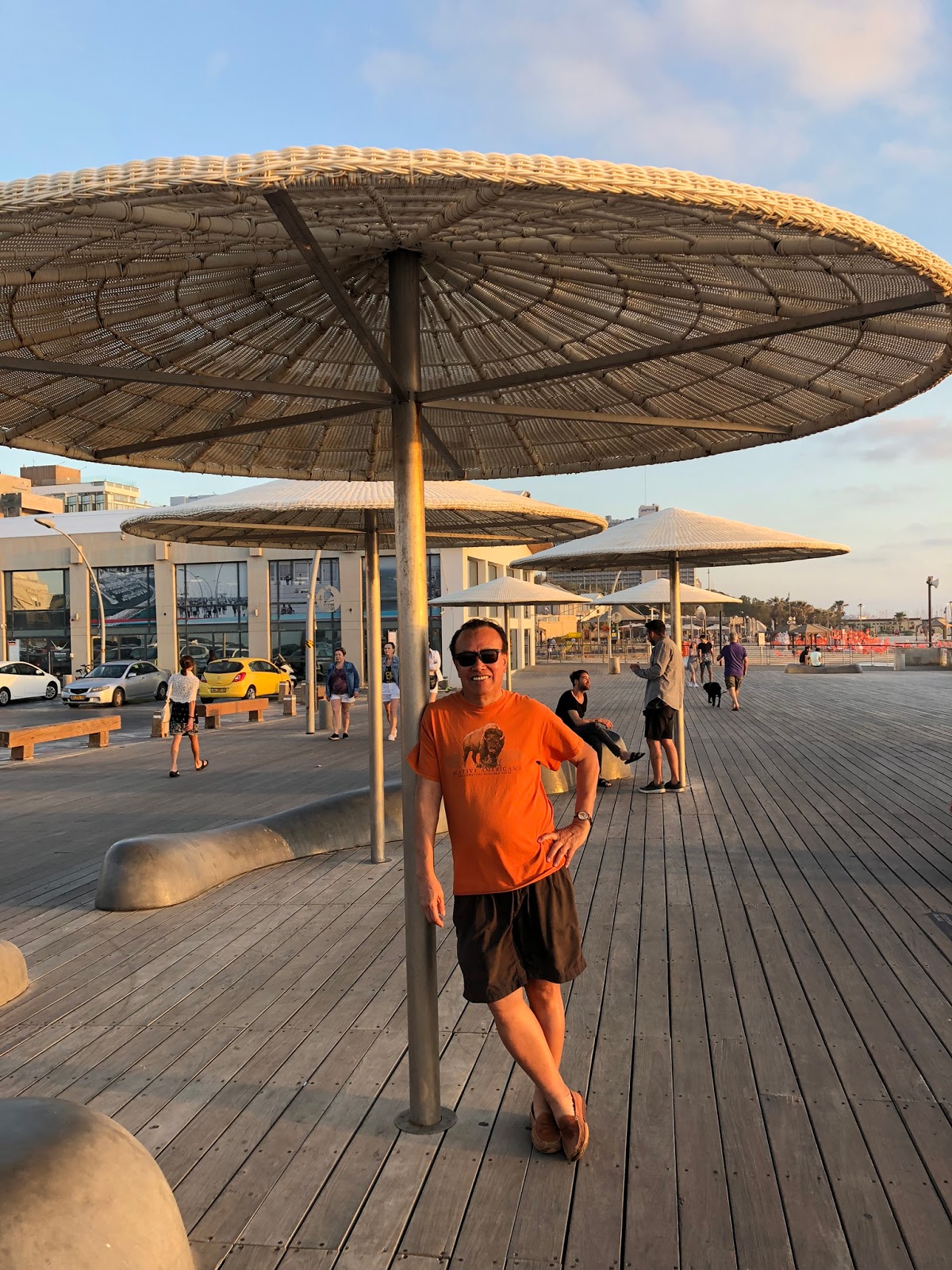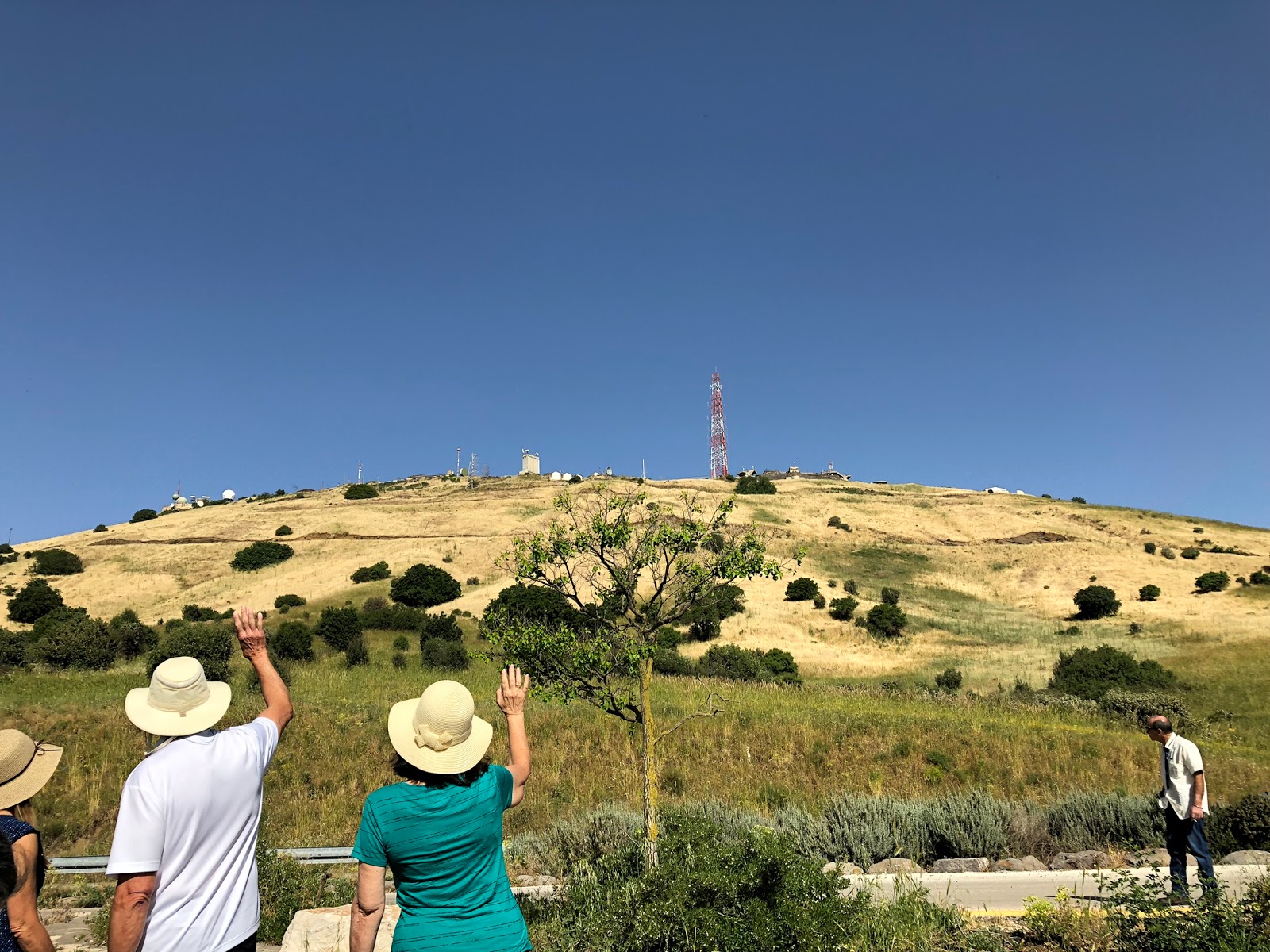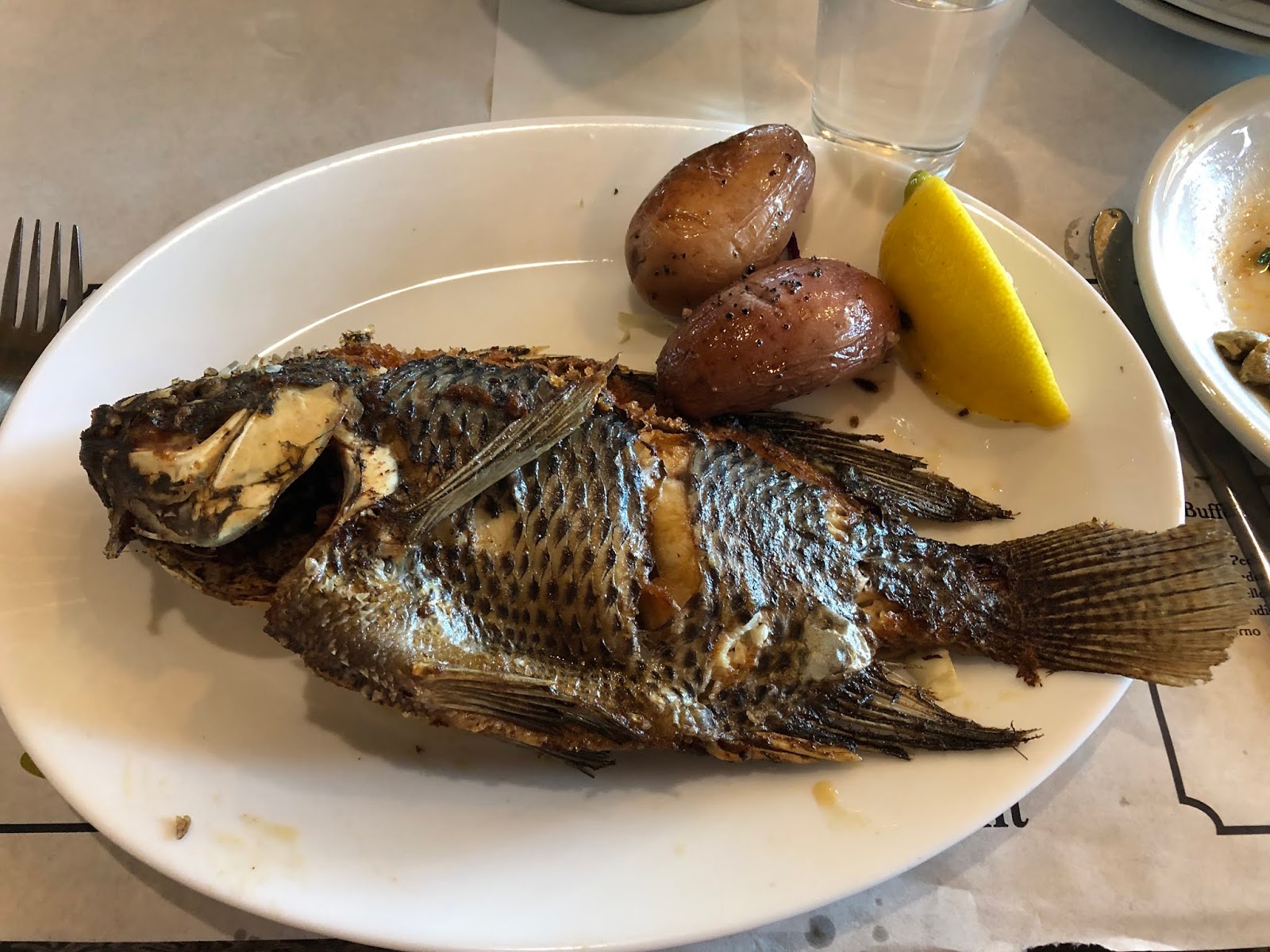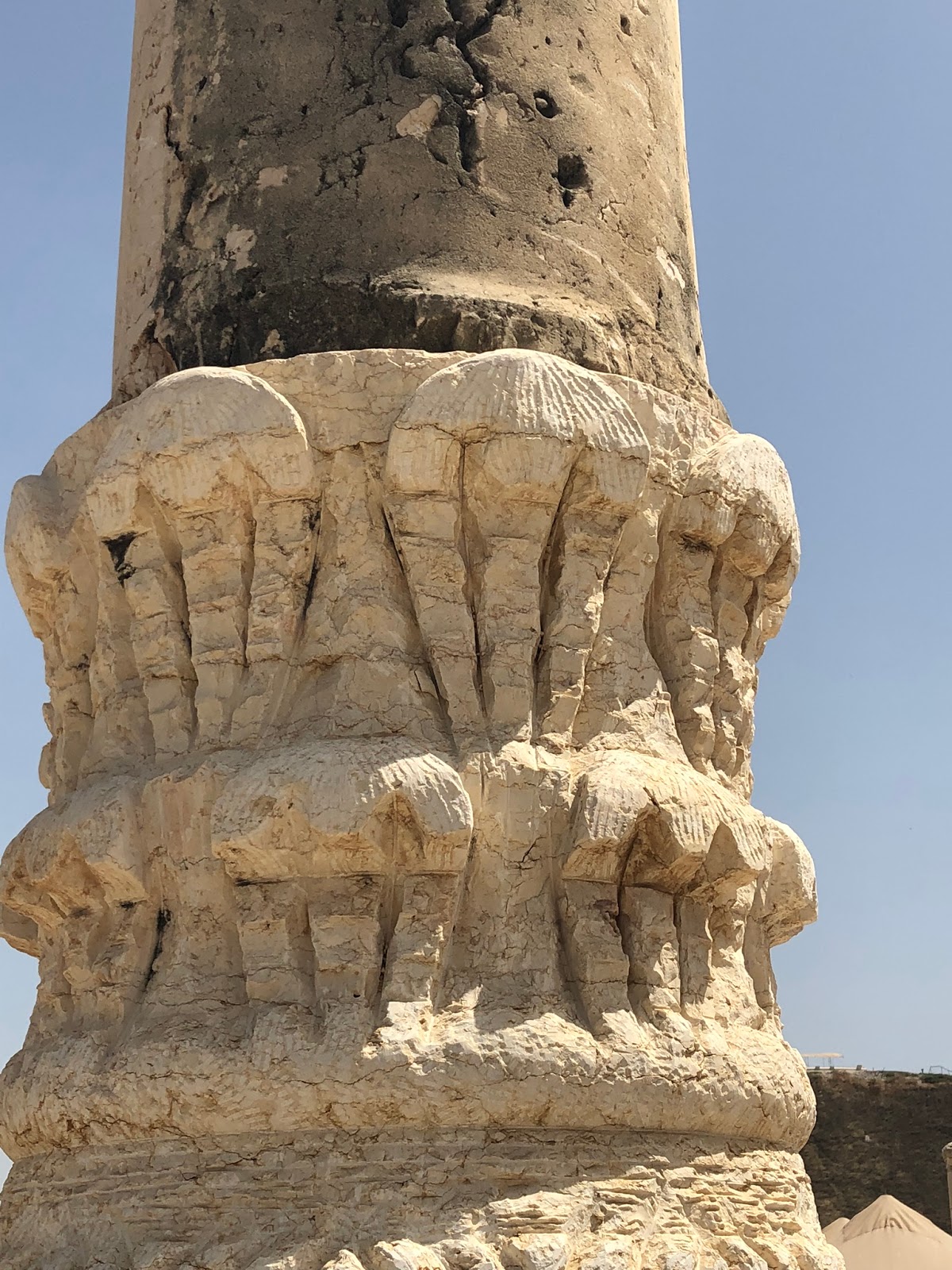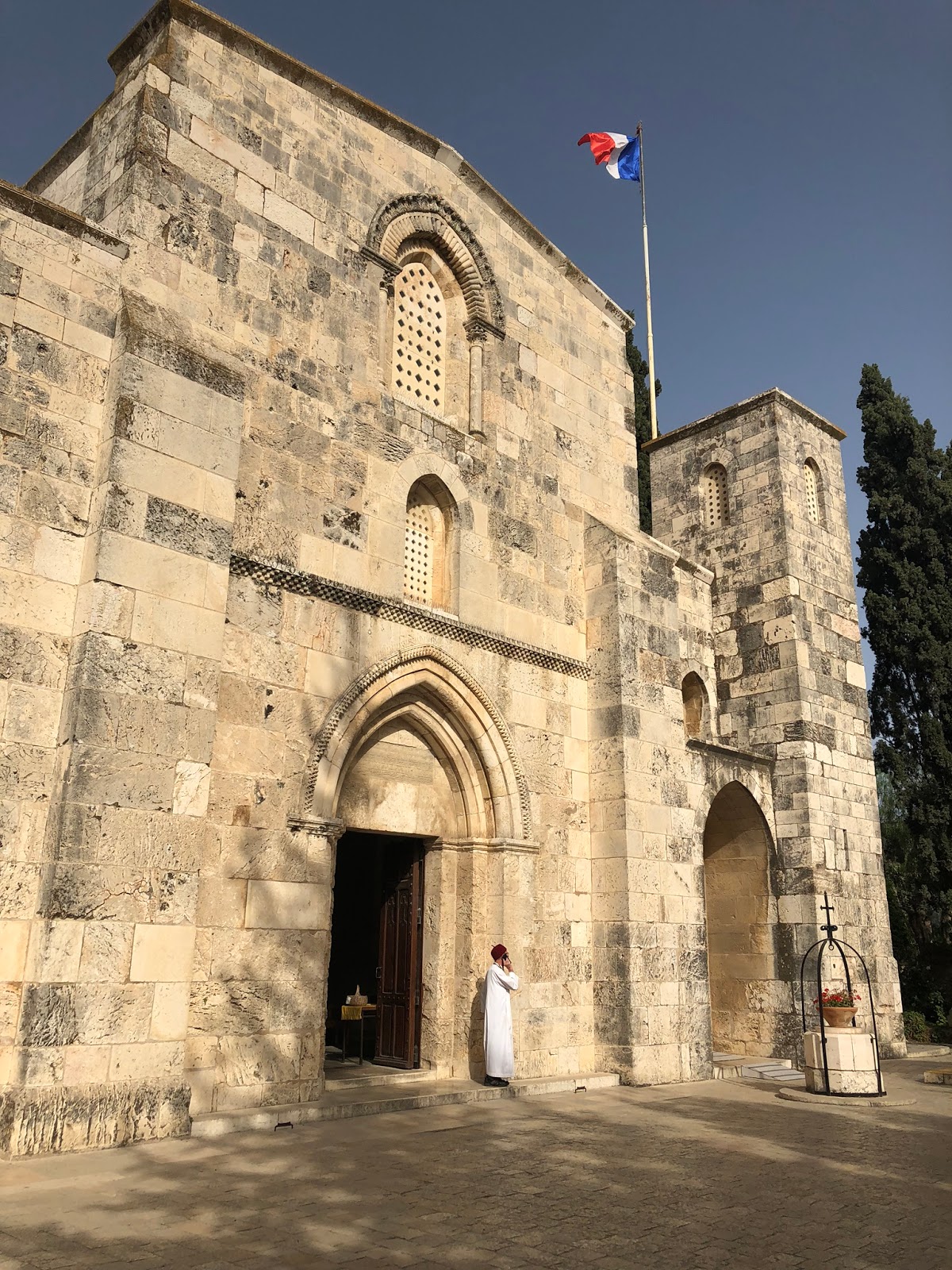------------------------------------------------------------------------------------------------------------------------------------------------------------------------------------------ISRAEL JOURNEY FOR THE BELIEVER
May 18-26, 2019
----------------------------------------------------------- ----------------------------------------------------------------------------------------------------------------------------
May 18-26
A JOURNEY FOR THE BELIEVER BY GATE 1
ISRAEL FLAG
May 18-19
JFK*MOSCOW*TEL AVIV
Finally touched down after a 9-hour flight to Moscow and waited for the next leg of our flight to Tel Aviv (another 4 hours). Stayed at the Tal Hotel in Tel Aviv where we had Happy Hour on the rooftop then went for a walk along the seaside boardwalk before our Welcome Dinner at the hotel restaurant.
May 20
CAESAREA MARITIMA*NAZARETH
Began our pilgrimage to the Holy Land with a drive northwards along the Plain of Sharon, the Mediterranean and old coastal road. The first stop was the ruins of Caesarea Maritima, built by Herod and where Roman Governor, Pontius Pilate, based his seat of government. It became an important early center of Christianity during the Byzantine period, but destroyed during the Muslim conquest of 640. After being re-fortified by the Muslims in the 11th century, it was conquered by the Crusaders, who strenghtened and made it into an important port, and was finally slighted by the Mamluks in 1265. Then we traveled north and ascended Mt. Carmel to view the Carmelite Monastery.
Enjoyed the panoramic views of the Jezreel Valley, also known as the Valley of Armageddon, viewing Megiddo, one of King Solomon's walled, fortified cities, then continued along the pastoral hills of Galilee to Mt. Precipice, the traditional site of the cliff that an angry mob attempted to throw Jesus off of after his bold proclamation in the Nazareth synagogue, to the town of Nazareth, the hill country of Galilee where Jesus grew to manhood. Here, we visited the Church of the Annunciation where the angel Gabriel told Mary she would bear a child.
May 21
GOLAN HEIGHTS*BANIAS*TABGHA*CAPERNAUM*GINOSAR*SEA OF GALILEE
This morning we drove north to the Golan Heights. which Israel seized in the 1967 Six-Day War, and saw in the distance Mount Hermon and its snow-covered mountain tops. Then we stopped to visit Banias (also called Caesarea Philippi), an ancient site that developed around a spring and associated with the Greek god Pan and other deities. The Banias River is one of the main tributaries of the Jordan River.
We continued to Tabgha, the site of the multiplication of the Loaves and Fishes) and the Mount of Beatitudes where Jesus preached His famous "Sermon on the Mount".
The day continued with a lunch stop at St. Peter's Restaurant which is along the Sea of Galilee.
Next stop was Capernaum, the town where Jesus chose His first disciples among the humble local fisherman. We viewed the archaeological site which revealed 2 ancient synagogues built one over the other and the remains of a house, believed to be the home of St Peter, turned into a church by the Byzantines.
Next we visited the Ancient Galilee Boat also known as Jesus Boat at the Yigal Allon Museum in Ginosar. It is an ancient fishing boat from the 1st century AD discovered in 1986 on the shore of the Sea of Galilee.
We next sailed on the Sea of Galilee.
May 22
YARDENIT*BET SHE'AN*JERUSALEM
Another spiritually enriching day begins at the headwaters of the Jordan River, the Yardenit, where Christian visitors come to renew their faith with a traditional Baptism.
Continued southward to the remarkable ruins of Beit She’an, a city mentioned in the Bible, later a Hellenistic, Roman and Byzantine city which was destroyed by an earthquake in 749 AD. It was here that the Philistines hung the bodies of Saul and his sons on the walls of the city. Walked through the incredible excavations of the largest ongoing archaeological dig in the land of Israel, with its amphitheater, colonnaded Roman streets, mosaics and Roman bathhouse.
Proceeded south toward Judea, through the lush Jordan Valley and passing by the ancient city of Jericho. Arrived at the Holy City of Jerusalem for observation of the city from the Mount of Olives with its panoramic view of the entire Old City. Tracing the footsteps of Jesus, continue down the Palm Sunday route to the Garden of Gethsemane and the Church of All Nations. End the day just outside the city walls with a visit to the Garden Tomb, first identified in 1849. A rock formation resembles a skull (Golgotha) and the site accords with the biblical data of the area where Jesus was buried.
Panoramic view of the Old City of Jerusalem from Mount of Olives.
Getsemane and the Church of All Nations
Garden Tomb. a site of Christian worship with an ancient Jewish tomb which many believe is the site of Jesus of Nazareth’s burial and resurrection.
May 23
BETHLEHEM*OLD CITY, JERUSALEM
This morning we drove to Bethlehem, a city located in the central West Bank, Palestine, and our first stop was the Shepherds Field, the scene where the Angel of the Lord visited the shepherds and informed them of Jesus' birth.
Chapel of the Shepherds' Field marks the place where, according to Catholic tradition, the angels first announced the birth of Christ.
Next we visited the Church of the Nativity, a basilica located in Bethlehem in the Palestinian West Bank. The grotto it contains holds a prominent religious significance to Christians of various denominations as the birthplace of Jesus. The grotto is the oldest site continuously used as a place of worship in Christianity, and the basilica is the oldest major church in the Holy Land. The church was originally commissioned by Constantine the Great a short time after his mother Helena's visit to Jerusalem and Bethlehem in 325-326. Over the centuries, the surrounding compound has been expanded, and today it comprises three different monasteries: one Greek Orthodox, one Armenian Apostolic, and one Roman Catholic. The silver star marking the spot where Christ was born was stolen in 1847.
Since 2012, the Church of the Nativity is a World Heritage site and was the first to be listed by UNESCO.
Church of Nativity
Back in Jerusalem our Israeli guide rejoined us and we went to see more religious sites in the Old City: entered through the “Dung” gate and saw the Wailing Wall. Walked through a long tunnel which is adjacent to the Western Wall and is located under buildings of the Old City of Jerusalem. There’s a place in the tunnel which is the closest point a Jew can pray near to the Holy of Holies, assuming it was located at the traditional site under the Dome of the Rock.
Outside we saw the Chapel of the Condemnation (1st Station of the Cross) and the Church of Flagellation (2nd Station).
We next visited the Eglise de Ste Anne and the Bethesda Pool before we exited through the Lions Gate.
May 24
KNESSET*SHRINE OF THE BOOK*OLD CITY, JERUSALEM
First stop is a visit to the Knesset, the Israeli parliament. In front is the Menorrah, a gift from the UK in 1948. Next is the Shrine of the Book, built to symbolize the scroll of the War of the Sons of Light Against the Sons of Darkness: the shrine is built as a white dome symbolizing the Sons of Light, and a black basalt wall - symbolizing the Sons of Darkness. The shrine houses the Isaiah scroll, dating from the second century BCE, the most intact of the Dead Sea Scrolls, and the Aleppo Codex, dating from the 10th century CE, the oldest existing Hebrew Bible.
Next we visited Yad Vashem, Israel's official memorial to the victims of the Holocaust. It is dedicated to preserving the memory of the dead; honoring Jews who fought against their Nazi oppressors and Gentiles who helped hide the Jews.
After lunch we went back to the Old City, which has been traditionally divided into four quarters—known since the early 19th century as the Armenian, Christian, Jewish, and Muslim Quarters. The Old City became a World Heritage Site in 1981. We entered through King David Gate to walk to the Via Dolorosa and the Stations of the Cross and end up in Golgotha at the Church of the Holy Sepulcher. Then on to King David’s tomb and the supposedly site of the Last Supper. Afterwards we visited St Peter in Gallicantu.
May 25
MASADA*DEAD SEA
This morning we went to Masada, an ancient fortress in southern Israel’s Judean Desert. It's on a massive plateau overlooking the Dead Sea. A cable car and a long, winding path climb up to the fortifications, built around 30 B.C. Among the ruins are King Herod's Palace, which sprawls over 3 rock terraces, and a Roman-style bathhouse. According to Josephus, the siege of Masada by Roman troops at the end of the First Jewish–Roman War ended in the mass suicide of 960 people, the Sicarii rebels and their families who were hiding there. Masada was declared a UNESCO World Heritage Site in 2001.










